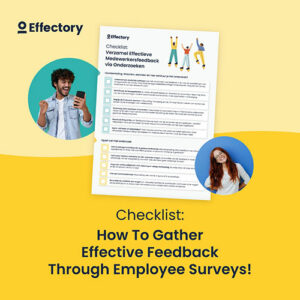Part 1 discussed the purpose, stakeholders and anonymity of your employee survey. This second part addresses how to draw up your employee questionnaire and includes guidance on question formulation, determining an answer scale and how to create attractive questionnaires.
Step #1: Preparing your employee survey (part 2)

Drawing up the employee questionnaire
Questionnaire main topics
Based on your survey objectives and the interests of all the parties involved, you have an idea of the important subjects to include in the employee questionnaire. Align the main topics with your business objectives and if you’re looking for a professional template based on scientific research and the latest HR expertise, take a look at our employee engagement survey model for charting the most important subjects relating to workforce perceptions.
Step #1: Preparing your employee survey (part 1)
Question formulation
The formulation of the questions determines the insight you will gather from your employees. Above all, it is important to consider whether to formulate the employee survey question in a positive, neutral or negative way. Avoid using a combination of these forms of questioning and try to formulate the questions in such a way as not to invite answers that are typically the social norm.
For example, adding the question: “I work efficiently” could result in a socially desirable answer (i.e. of course I work efficiently, but everybody else works inefficiently!). To reduce the possibility of gathering answers that are the social norm, you can ask the same question but address it at the level of the team or organisation.
By changing this question to “My team works efficiently” or “Within the organisation, we work efficiently”, you get a clearer, more realistic view of the actual efficiency of the organisation.
How to gather feedback from your employees
The definitive checklist for creating your employee engagement survey.
DownloadAnswer scale
Your employee questionnaire answer scale should be simple, quick and easy to understand. Your questions will determine the types that you use. For example, employee survey questions can require yes/no answers, descriptions or substantiation, or ratings across a scale. Here too are various possibilities:
- You can have employees evaluate each statement, giving a score of 1 to 10
- You can use the four-point scale. These options force employees to make a choice, without scope for a neutral answer
- You can opt for the scientific five-point scale, which gives employees the opportunity to give a neutral answer.
Questionnaire validity
It is important to use a validated employee questionnaire, as then you can be sure that you are asking questions that actually measure what you intend to measure. Since the validation of questionnaires requires research and corporate data, many organisations find it more efficient to use a tried set of employee survey questions. By doing so, you can then rest assured that you are asking the right questions.
Open questions
Some employees will want to say more than the employee questionnaire allows for. To give them this opportunity, you can include open-ended questions. The big benefit is that you can gain deeper insights. The disadvantage is the extra space required, which makes the questionnaire look and take longer. Try to limit the number of open questions; one or two open questions at the end are usually sufficient.
When assessing whether there is a need for open answers, it is wise to consider the issue of multiple languages. When there are several nationalities working in one team and employees respond in their own language, this could diminish the feeling of anonymity. In this case, make sure that all open answers are translated into one language to maintain confidentiality.
Let’s talk about employee feedback
Leave us your details, and schedule a time that suits you best and we’ll be in touch! We’re more than happy to help you.
Make an appointmentAttractiveness of the employee questionnaire
Content
On seeing the questionnaire, employees should find it an attractive proposition to answer. You should therefore keep it concise. Focus on the main issues and only include statements relating to issues that you can act on. Do not use additional questions in the questionnaire to allow employees to express their opinion of the importance (or otherwise) of certain issues. This will make the employee questionnaire unnecessarily long, leading to unreliable information.
Form
Above all, make sure the questionnaire looks attractive. For example, use your corporate colours and logo. This will make the employee questionnaire recognisable and considerably increase the response rate.
Multiple languages
You should compose the employee questionnaire in the language spoken by the employees. If, for example, your organization is headquartered in Germany but staffed largely with Polish blue collar workers have a poor (or inadequate) command of German, the answers to a German language questionnaire will be unreliable. In nearly all cases you should try to use the languages that are normally spoken within your company, which in this case would be Polish.
When using employee questionnaires in multiple languages, it’s essential that the questionnaires are cross-checked for translations. Correct and reliable translations are extremely important, so try to use a reliable and trusted translation agency. Always remember that if the translation is unreliable, the data collected will also be unreliable.
Read more
Read the whole series on how to create engaging employee surveys:
- Step #1: Preparing your employee engagement survey (part 1)
- Step #1: Preparing your employee engagement survey (part 2)
- Step #2: Communicating your employee engagement survey
- Step #3: Implement your employee engagement survey with impact
- Step #4: Analysing your employee engagement survey
- Step #5: Taking action!
Book a free demo. See our solutions in action.
Effectory is Europe’s Leading provider of Employee Listening Solutions. Schedule a product demo and discover how to enhance your employees’ engagement.
Demo request

